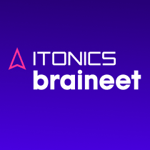TL;DR? Got no time? No problem. The key takeaways from this article are:
- Instead of thinking about how to buy more time to get more things done, it's more advisable to think about how to continuously increase the output of your activities. To increase your output, it's not simply a matter of prioritizing and delegation, but rather of leveraging the activities you perform.
- You will want to have both the highest-impact and most positive leverage for your activities. In Innovation Management, front-end activities, in particular, have high-impact and positive-effect leverage. Such activities that hold high leverage and affect the output of the entire organization include, trend, technology, startup, and innovation scouting, scenario creation and planning, challenging existing innovation initiatives, and triggering new ones, training and coaching of other teams on emerging trends and technologies, and influencing innovation strategy and culture. The earlier the course is set in the innovation process, the greater the leverage effect.
- By adding artificial intelligence to the equation, you can automate a large portion of front-end activities while simultaneously increasing the output of those activities - another high leverage activity on top.
- Introducing and establishing a digital innovation platform for all foresight and innovation activities not as "just another tool to manage," but rather as a digital home for all high-leverage activities, is in itself an additional high-impact activity with a positive effect that benefits the entire organization.
Time
Simple fact: There is always more to do. In our professional lives, nothing is ever truly "done" - there is always more to learn, to build, and to improve. I often observe that managers, in particular, struggle with this realization and then default to simply doing "more" of the same: Why not answer a few emails over morning coffee? Why not make a few quick phone calls during lunch break? Why not add another project on top of everything else?
Simple truth: There is nothing more precious than time, and we all only have 24 hours of that resource in a day - but we have full control over how we spend it. However, the question is not how we can work even more hours - but how we can continuously increase our output.
Many tools have been developed for this typical prioritization problem. The list is extensive, including the Eisenhower matrix, "eat the frog" (according to Mark Twain, i.e., tackle the hard stuff first), "the customer who shouts loudest wins," delegate tasks, and so on.
Yet, in spite of this, I think that most managers just roll with it and keep going with their daily hustle. Somehow it just doesn't feel right. This has led me to consider how we can think about our use of time differently?
Managerial Leverage
Enter Andrew Grove, former CEO of Intel. In his book High Output Management, he introduces the idea of representing a manager's output as the output of his/ her team + the output of the neighboring teams under her/ his influence.
What can be done to increase the output? More activities? Sure. Improved delegation? Certainly. Involvement across more neighboring teams? Of course. Another perspective is the concept of leverage. Consider this simple equation:

'A' represents the activity itself, and 'L' its leverage.
The theory: For every activity performed, the output of the organization should increase by some degree. The extent to which that output is increased is determined by the leverage of each activity, namely L1, L2, …, Ln. The leverage itself can be described across two dimensions: impact and effect. Consider the following matrix:
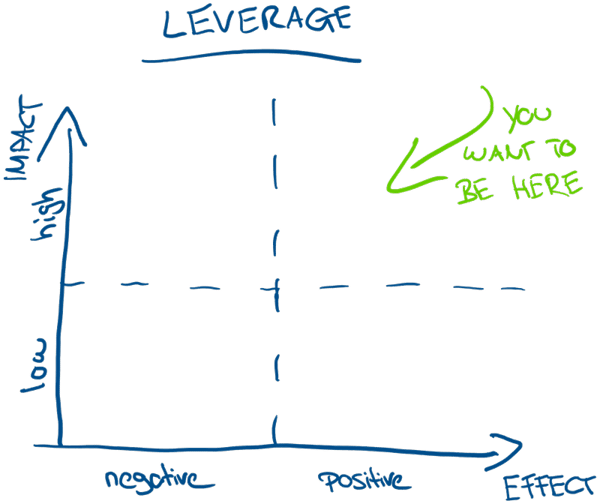
Long story short: You will want to introduce as much high-impact positive-effect leverage as possible to your activities. Instead of simply doing "more of the same," you should focus on leverage as a point of prioritization.
High-Impact & Positive-Effect Activities
Let's first consider what high-impact activities are. Here are a few characteristics:
- High-impact positive effect activities affect many people
- The action and/ or its outcomes have a prolonged effect sustained over a long period of time
- Such activities apply new methods and tools and thereby, change collective ways of working for teams
Ideally, you will want to focus on high-impact activities that also have a positive effect, influencing the subsequent work of teams. A few examples of such activities include:
- Annual and quarterly planning, thus providing orientation for many people in the medium to long term
- Training, coaching, feedback, and continual reviews, thus impacting the performance of one or multiple individuals for a long period of time
- Onboarding of new team members to increase the potential output in the future
- Introducing dedicated methods and tools to further increase leverage
Meanwhile, you will want to avoid high-impact activities that have a negative effect at all costs. A few examples of such activities include:
- Lack of preparation as a key participant. This only results in wasted time for all.
- Spreading bad vibes that diffuse through teams and negatively impact both team and individual performance. This can have a nearly unlimited negative effect!
- Indecision as a leader. No decision = a negative decision; no green light is a red light.
The Front End of Innovation: Highly-Positive Leverage
From this point of view, we can intuitively understand why professional innovation management - including well-managed front-end and corporate foresight activities - is invaluable.
Let’s consider a typical high-level innovation process with preceding corporate foresight activities:
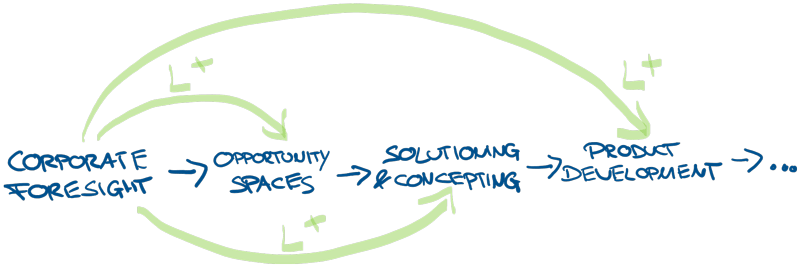
Out of this process, there are several examples of corporate foresight activities that produce valuable outputs for subsequent process steps:
- Emerging trend and technology scouting provides an early-stage indication of the direction markets and technologies are developing in
- The centralization of specialist task teams (e.g., establishing an emerging technologies group), applies the collective experience and knowledge to positively affect the work of many other employees
- The introduction of new tools and informal training (e.g., the use of a collaborative technology radar for environmental scanning and scouting activities), enhances ways of working for supporting teams
- The development of future scenarios drive search fields and opportunity spaces for innovation initiatives, helping teams better prepare future activities
- Challenging existing innovation initiatives and projects ensure activities are more successful and go on to trigger new innovation initiatives
In addition to this, activities in corporate foresight and the front end of innovation as a whole influence several other areas:
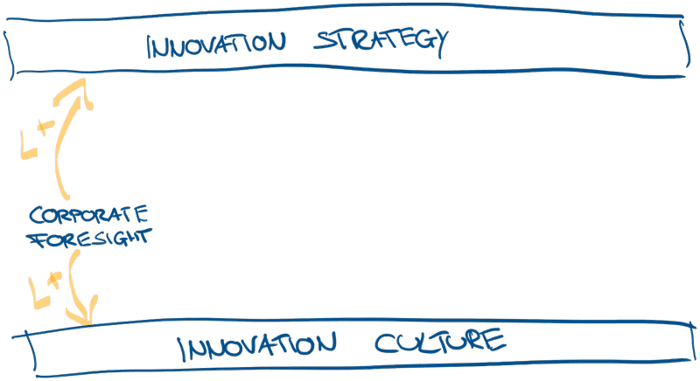
On a longer time horizon, both innovation strategy and innovation culture can be significantly influenced. A few examples are:
- Early identification of emerging trends and technologies can influence the discussion around first-mover advantage (vs. being a fast or even late follower)
- A thorough scenario planning process can spur the discussion around where to place one’s bets, e.g., how much weight is allocated to sustaining, incremental, radical, and disruptive innovation initiatives
- The mindset, activities, and communication in dealing with innovation influence the public and internal perception of the company's innovation strength, affecting the innovation culture in the long run
Adding Artificial Intelligence to the Mix
To further enhance the efficiency and the effectiveness of corporate foresight and innovation management well-chosen techniques from machine learning and artificial intelligence (AI) can be introduced to significantly increase and scale the highly positive leverage:
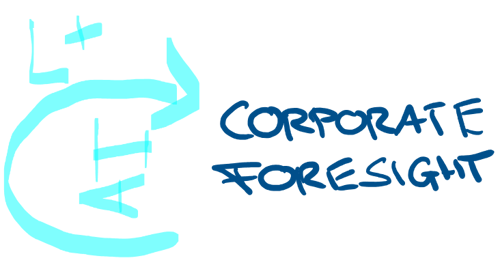
With these techniques, managers can invest a greater proportion of their and their team’s valuable time in creative tasks such as interpreting data analysis results, making decisions, and taking action - giving them a potential advantage over other market participants. In this way, the early phases of the innovation processes can be designed and implemented in an even more targeted manner, which increases the likelihood of successful innovations.
AI can be applied in a large variety of use cases, such as trend scouting, technology scouting, startup scouting, competitor monitoring, and risk monitoring. It’s not only faster, but it can also continuously work and produce results at a theoretically unlimited scale.
A New Digital Home
To complete the picture, only one element is missing in the age of digitization. That is, a common, single point of truth and digital innovation platform to manage all of these activities:
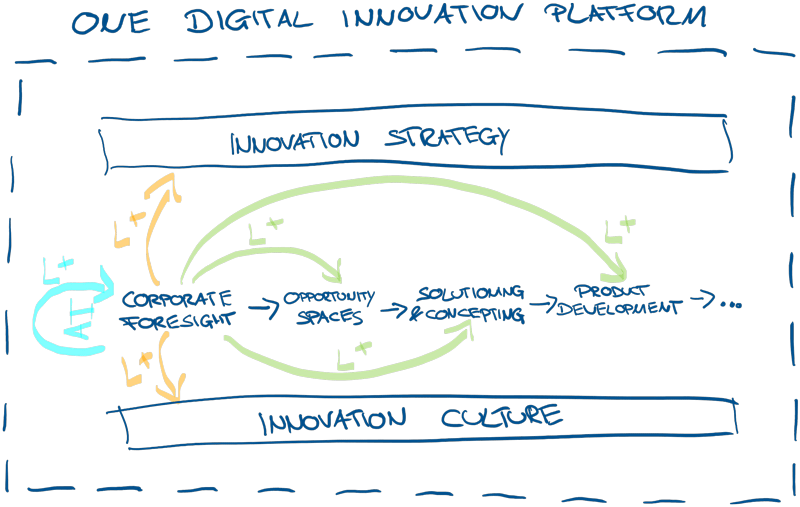
This platform is used as a tool to:
- connect associated internal as well as external data,
- store knowledge, form connections, and make it accessible to everyone,
- foster collaboration across time and space,
- increase transparency along the innovation process, and
- make better-informed decisions for investing in the future.
Recalling the definition of high-impact and positive-effect leverage from above, it is quite easy to see from this perspective that one digital innovation platform is much more than "just another tool". The establishment of such a platform is not only itself an activity with a preferable leverage, but also a framework for improved management and transparency of all related activities.
Read on our resources-site or listen our Innovation Rockstars Podcast on how innovation leaders across the globe are already successfully implementing these concepts today.

/Assets%20and%20Heros/nav-thumbnail-toyota.webp?width=150&name=nav-thumbnail-toyota.webp)



